Lower Neuadd Reservoir (2021)
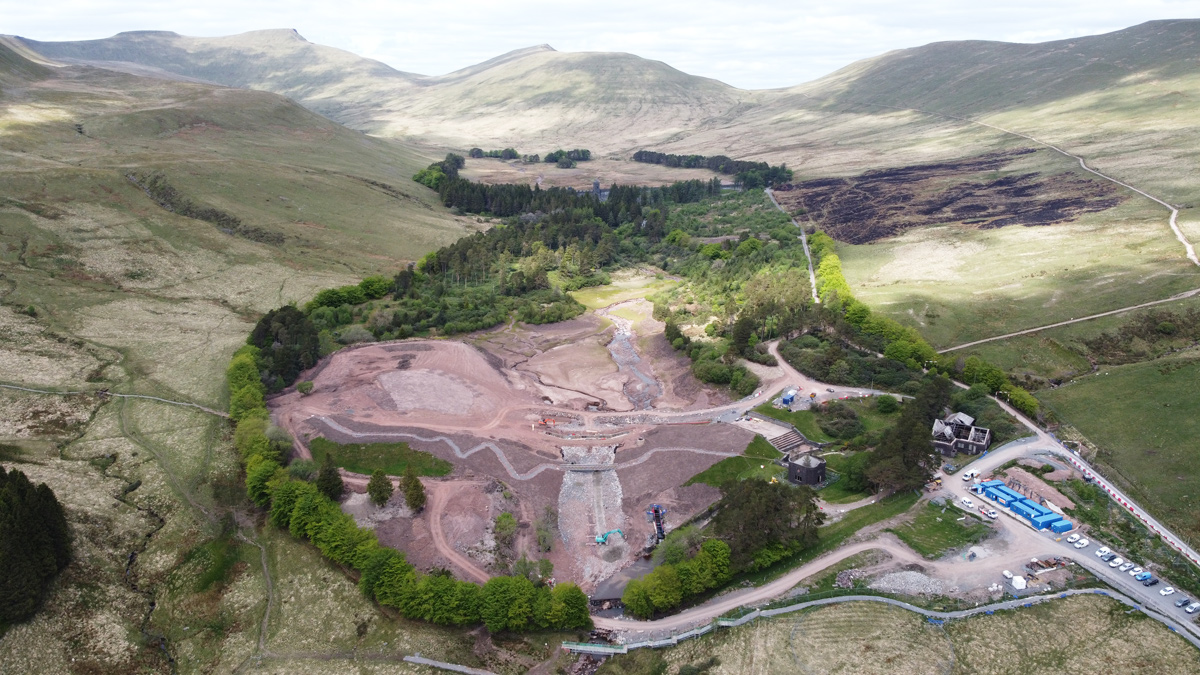
Overview of the site with Pen y Fan in the background - Courtesy of Skanska
Lower Neuadd Reservoir is located in the Brecon Beacons, 5km north of Merthyr Tydfil in south Wales. The reservoir, which is an embankment dam, was constructed in 1884. It is the middle of a cascade of three reservoirs, with Upper Neuadd situated 3km upstream of the much larger Pontsticill Reservoir. Lower Neuadd Reservoir had a capacity of 195,454m3 with a top water level of 427.6mOD. Lower Neuadd Reservoir was no longer used for water supply and did not form part of Dŵr Cymru Welsh Water’s Water Resources Management Plan. Furthermore, there was concern regarding the age of the dam and the deteriorating spillway channel. Taking this into consideration along with the high cost to bring the dam back into safe operations and to comply with the Measures in the Interest Of Safety (MIOS), it was proposed to discontinue Lower Neuadd Reservoir.
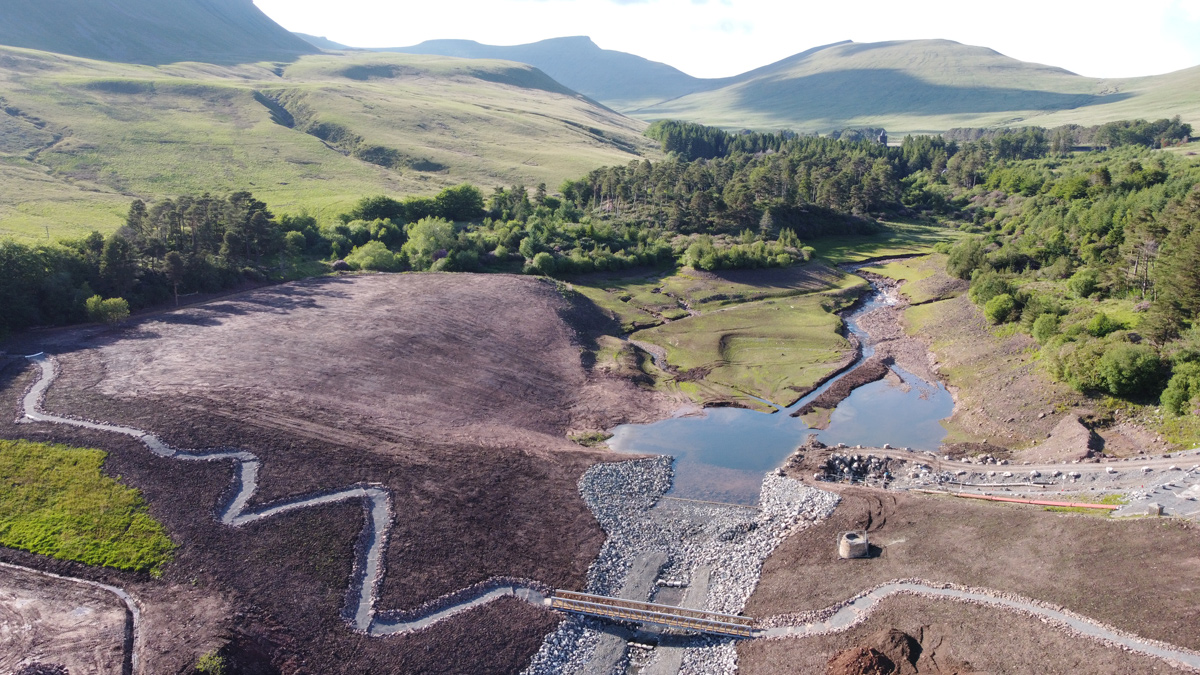
Re-use of fill material to create the natural valley shape in the top left of the photograph – Courtesy Skanska
Optioneering
A long list of options was compiled to decide the best means of discontinuing the reservoir. The options considered CAPEX, OPEX, risks, operations and maintenance, health and safety, constructability, and environmental impacts.
The chosen solution was a notch in the reservoir embankment, to a level 10m below the existing spillway. This solution included:
- Restoring the right valley side of the reservoir basin with naturalistic landscape features to meet the remainder of the embankment.
- Allowing the natural processes to reform a river channel within the reservoir basin.
- Installing a weir structure at the upstream edge of the notch. This forms a small reservoir for aquatic habitats to be established.
- Repairing and retaining the existing spillway along with interpretation display boards to explain and symbolise the industrial heritage of the reservoir.
- Maintaining the horizontal alignment of the public footpath across the dam, with a footbridge over the watercourse at the base of the notch.
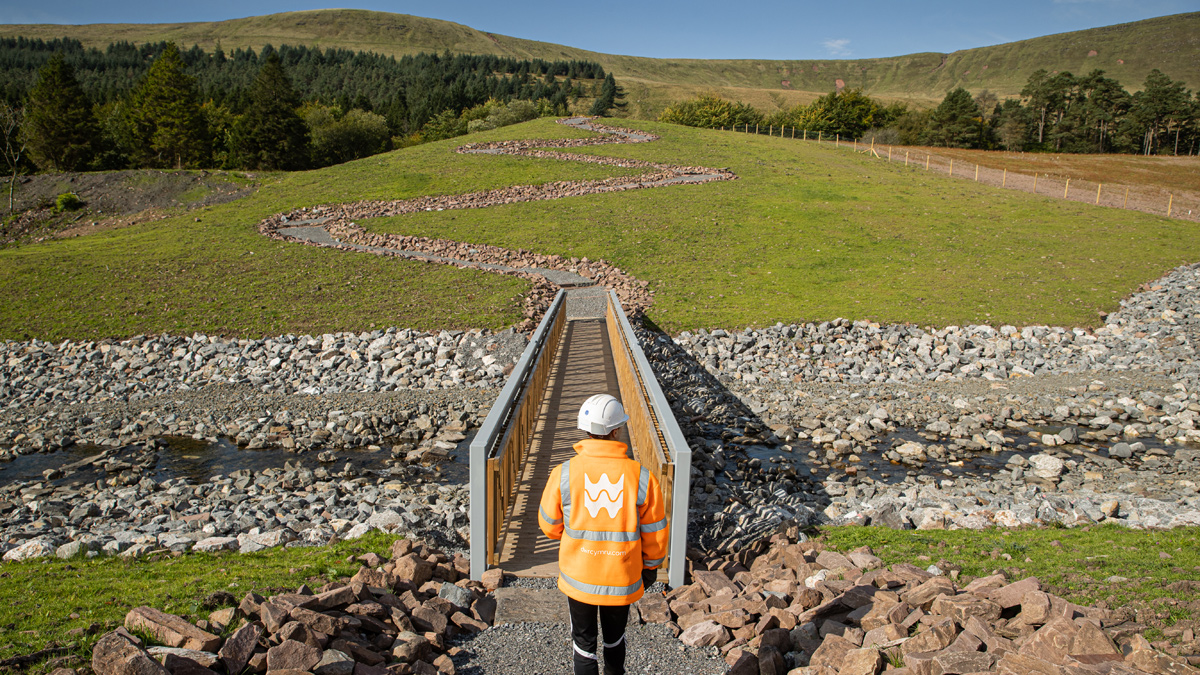
Footbridge – Courtesy of Skanska
Environmental impact assessment screening opinion
Under the Town and Country Planning (Wales) regulations 2017, an Environmental Impact Assessment (EIA) of the scheme was required. This posed a key risk to the project, as a requirement to undertake a full impact assessment would have caused potential prosecution and loss of reputation by missing the statutory deadline imposed under the Reservoirs Act 1975. Furthermore, the client’s permitted development rights would have been revoked, resulting in full planning permission.
Early engagement with Brecon Beacons National Park Authority (BBNPA) resulted in a modified design that reduces the projects impact on the national park. This was captured in an extended screening opinion which went into more detail than a standard screening opinion. This resulted in a negative screening opinion from BBNPA and an estimated saving of 12 months off the programme in addition to not missing a regulatory date.
Lower Neuadd Reservoir discontinuance: Timelapse footage October 2019 – June 2020 – Courtesy of Skanska
Waste management
The chosen solution involved the removal of over 60,000m3 of dam material and about 3000m3 of silt from within the reservoir basin. Without strategic consideration during the design phase, this material would have been defined as waste and therefore its disposal (even if disposed of on-site) would have incurred a landfill tax of approximately £1.6m. In addition to the landfill tax, if the material had to be disposed of off-site, this would have incurred significant haulage costs as well have traffic management of haulage vehicles in a remote area with limited access.
The opportunity to reuse the materials on site to create a landscape sympathetic to the surrounding area, which provided a sustainable and commercial advantageous solution, and by using the Contaminated Land: Applications in Real Environments (Cl:aire) definition of Waste Code of Practise it was possible to avoid defining the material as waste.
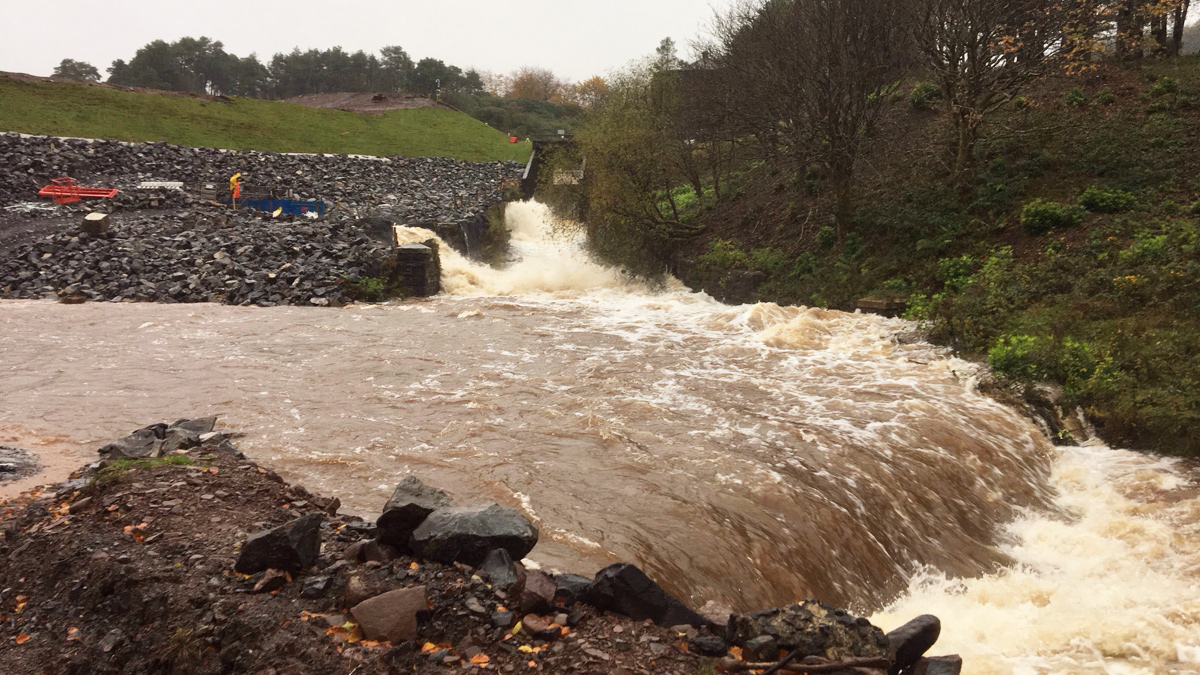
Downstream protection after heavy rain – Courtesy of Skanska
Flood protection during construction
The spillway was at 427.6mOD, and the top of the embankment was located at 432mOD. When the reservoir was full, water would flow over the spillway. However, as the embankment height is reduced to form the notch, the notch height (final level = 417mOD), becomes lower than the spillway. This then becomes the new ‘spillway’ for water to exit the reservoir when full. This, combined with the mountainous catchment area, provided a serious challenge.
An overtopping notch could result in a dam breech, so to protect the downstream face of the dam and prevent an overtopping event becoming a dam breech, rock armour was placed at the toe of the embankment to a critical level determined by the design team. Above that critical level, the well-established grass at the top was maintained. The innovative rock armour solution re-used the material to line the new river channel after the completion of the excavation, and thus reducing the need for additional construction traffic through the national park.
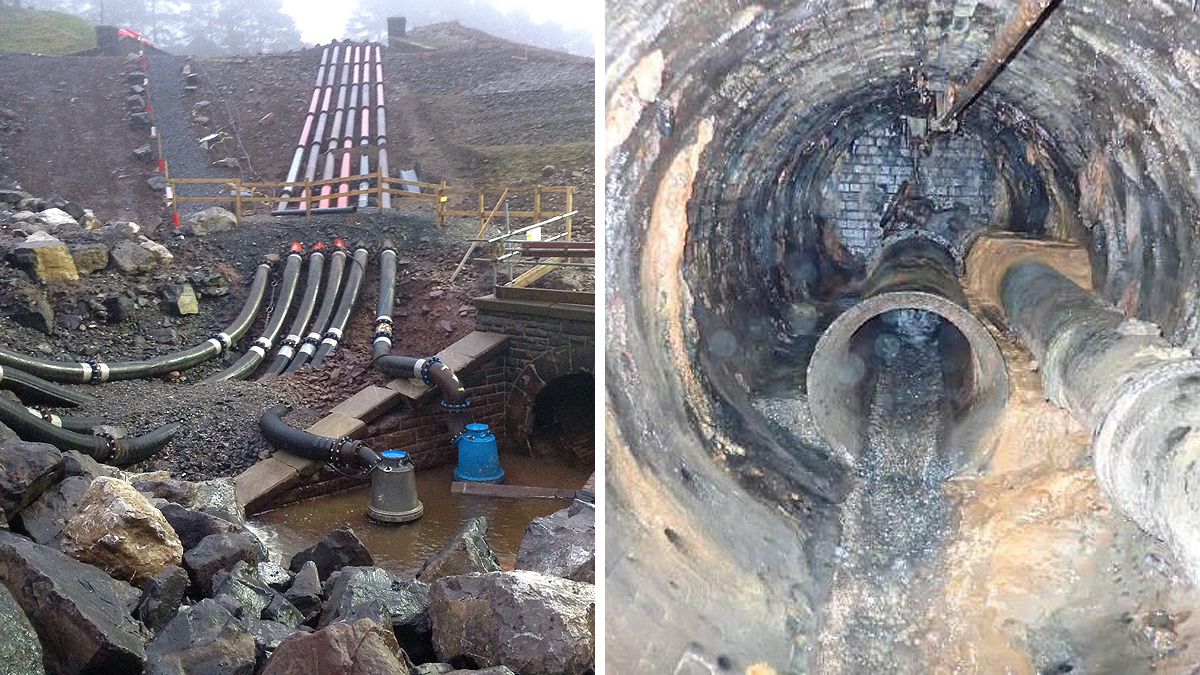
(left) Over-pumping at the entrance to tunnel and (right) tunnel plug pre-removal – Courtesy of Skanska
Lower Neuadd Reservoir discontinuance: Supply chain – key participants
- Client: Dŵr Cymru Welsh Water
- Principal contractor: Skanska
- Civil contractor: Atlas Building & Civil Engineering
- Lead designer: Arup
- Geotechnical investigation: Geotechnics Ltd
- Pipe removal & unplugging tunnel: Edwards Diving Services
- Landscaping: Hortech
- Ground investigation: Quantum Geotechnic
- Muck shifting: McCarthy’s
- Bridge designer & installer: Beaver Bridges
- Bathymetric survey: APEM
Water management
In addition to over-pumping water over the spillway to maintain a low water level, it was crucial to remove the tunnel plug, to allow water to flow out the reservoir via the tunnel. The 1.8m diameter tunnel was located at the lowest part of the reservoir and was capable of conveying a one-year storm event. The tunnel has now been filled with foam concrete, to ensure structural integrity for the future. The tower connected to the tunnel was partially demolished. Parts of the tower were left in place as a nod to its heritage.
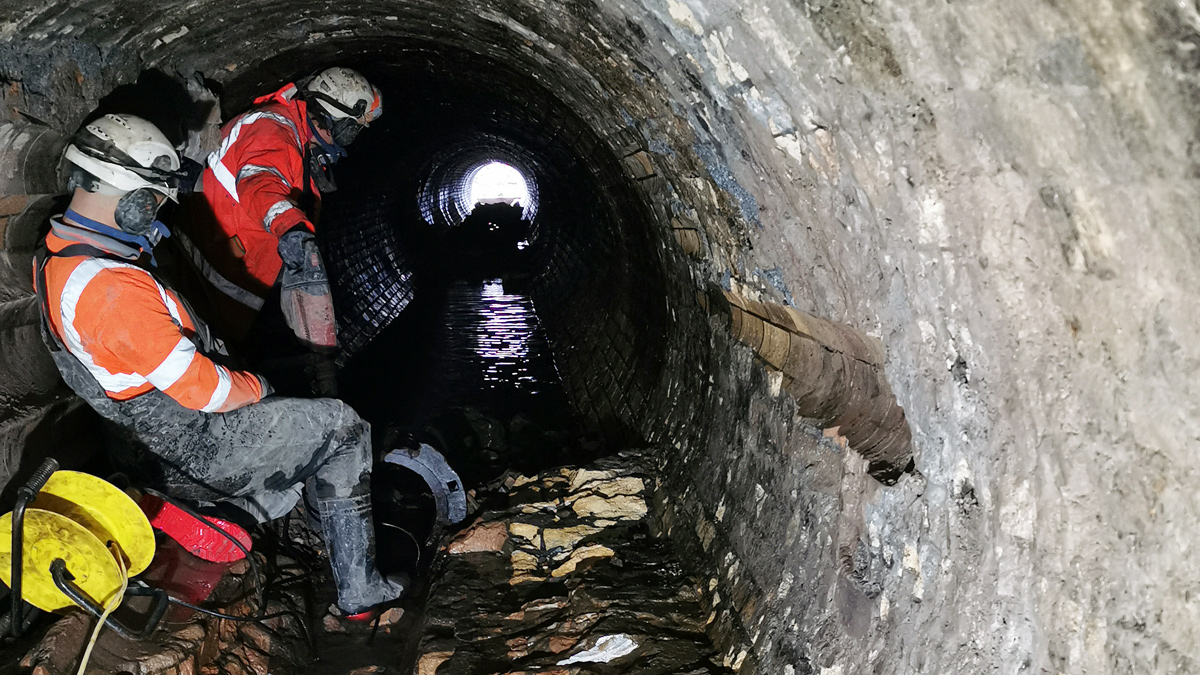
Removed tunnel plug – Courtesy of Arup
Sustainability
Sustainability has been at the core of this project; a number of initiatives including:
- Reuse of fill material to recreate the natural valley shape.
- Reuse of rip rap: first as downstream slope erosion protection then to line the river channel in its permanent state. In doing so, avoiding installing a concrete spillway.
- Selecting a wildflower seed mix for the newly landscaped area which was suitable to the dam fill material. As a result, this did not require top soiling 12500m2 and saved several vehicle movements through the national park.
- Improving the biodiversity of the area by installing 21 nesting boxes for birds, bats, and owls, made from recycled timber.
- Recycling timber from the dam to create seating along the newly formed footpath.
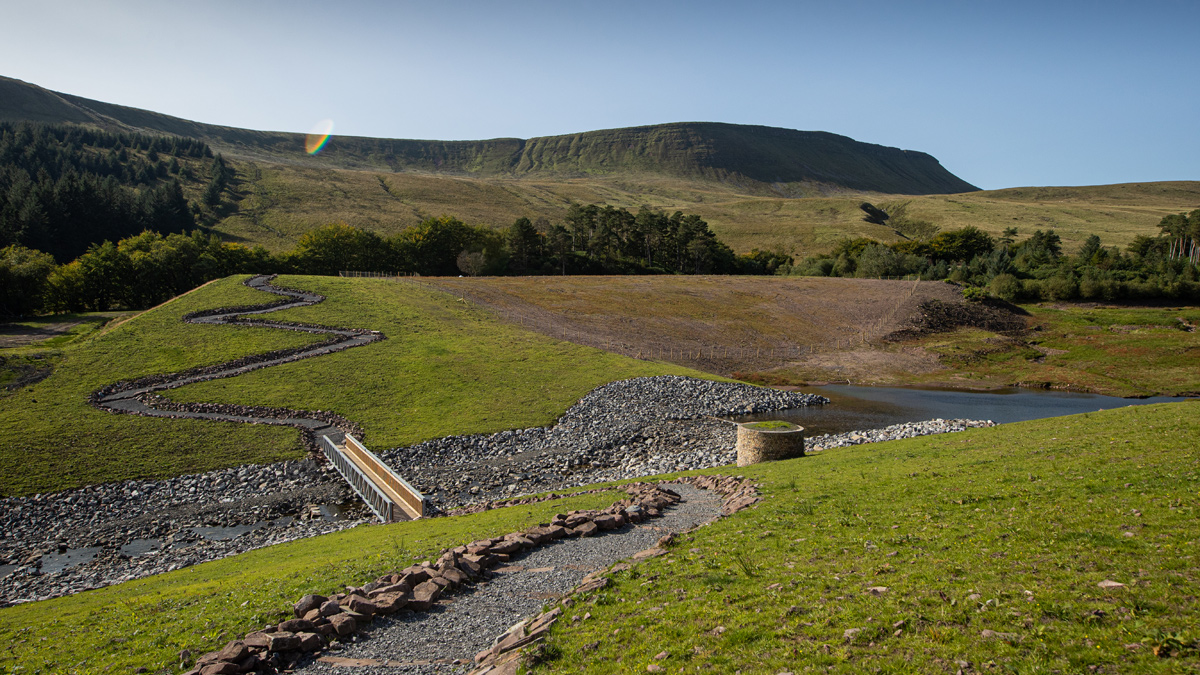
Project overview – Courtesy of Skanska
Conclusion
Lower Neuadd Reservoir was a popular walking route with scenic views. The discontinuance of the reservoir in a mountainous area located in the middle of a national park added to the complexity of the discontinuance. However, the team have delivered a project to be proud of that blends into the natural landscape and meets its design requirements so that the area can remain as a popular walking route with picturesque views.



